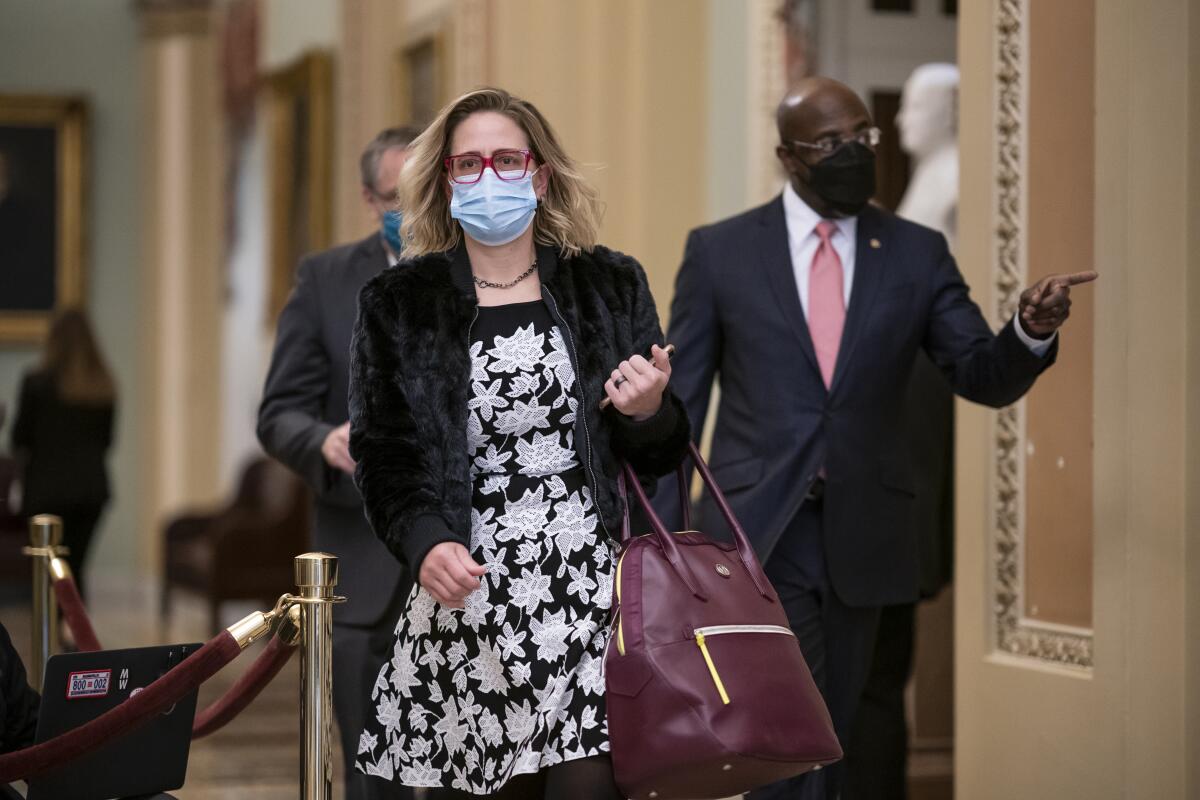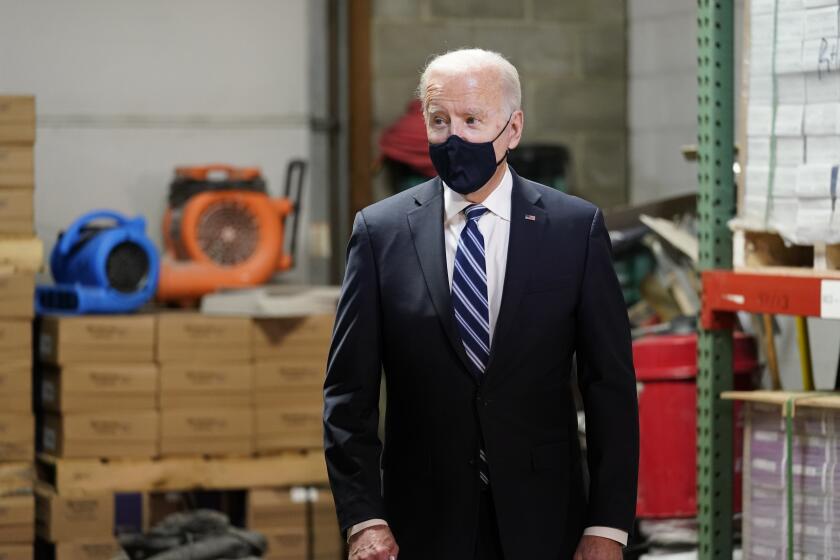For Arizona Sen. Kyrsten Sinema, being in the majority puts her maverick instincts to the test

- Share via
PHOENIX — Steve May can still picture the moment he was introduced to Kyrsten Sinema, nearly 20 years ago. He was then serving in the Arizona House of Representatives. She was a Green Party activist waging her first bid to win elected office — and she refused to shake his hand.
“All she knew about me was that I was a Republican member of the House,” May recalled. “She flipped around, her skirt whirled around and she just walked right away from me.”
Within a few years, she was a state legislator driving all across Arizona with May, as they worked to successfully thwart a ballot measure to ban same-sex marriage. Their partnership was a milestone in a transformation that has taken Sinema from a tutu-wearing antiwar activist to a conservative Democratic U.S. senator.
That evolution has taken on national consequence. For the first time in her career, she finds herself in the ruling majority party. In an evenly divided Senate where a single Democratic defection can upend President Biden’s agenda, Sinema, along with West Virginia’s Joe Manchin and a handful of other moderate members, has emerged with outsize influence.
With one emphatic thumbs down on including a minimum wage increase in the recent COVID relief bill, she cemented her reputation as someone willing to spurn the progressive wing of her party. More battles loom over her vow to uphold the Senate filibuster, even if that imperils Democratic priorities.
So far, Sinema’s success has hinged on her finely tuned political radar, which has led her on an idiosyncratic path to become the first Arizona Democrat elected to the Senate in a generation.
“She’s looking at defining what a Western Democrat looks like,” said Chuck Coughlin, a veteran GOP strategist in Phoenix who became a political independent in 2017. “A Western populist Democrat that’s not owned by the unions or traditional Democratic constituencies [like] minorities and women. She’s not going to be so pigeonholed.”
Indeed, Sinema, 44, defies easy characterization. She is known for bold fashion choices (she has worn candy-colored wigs to make up for missed dye jobs at the salon during the pandemic) and punishing workout regimens (she has competed in the Ironman triathlon and teaches cycling classes). A lawyer and social worker by training, she earned a PhD while running for Congress and still teaches classes at Arizona State University. Despite being relatively new to the partisan-gridlocked Senate, she evokes the chamber’s bygone days of cross-party cooperation to defend the filibuster rule.
After ex-President Trump’s baseless claims of voting fraud, Republican lawmakers across the U.S. push to change election rules. Arizona leads the way.
Just as Sinema has undergone a political shift, so has her home state. The onetime Republican bastion is much harder to peg these days — politicos there describe it alternatively as purple, magenta, red with blue splotches. Progressives in Arizona warn that alienating the state’s liberal base may not be the winning strategy it once was.
“She has a theory that picking fights with the left helps her,” said Emily Kirkland, executive director of Progress Arizona. “I think that is a real misreading of the moment.”
With a handbag slung over her shoulder, she appeared to make a pronounced demi-curtsy as she signaled a thumbs down for a minimum wage vote that was bound to attract attention. The echoes of the late Arizona Sen. John McCain, who used a similar thumbs-down gesture to block a bill to repeal the Affordable Care Act, were inescapable.
“She wants to see herself as a maverick. When McCain did these things, he bucked his party because he voted for something that would potentially save lives,” said Tomas Robles, executive director of Living United for Change Arizona, a Latino advocacy group. “Her votes have been the exact opposite.”
Sinema has said she backs a higher wage but disagreed with the procedural attempt to do so in the stimulus bill. The episode, though, spoke to a larger question of which Arizona voters Sinema is courting. Many observers noted that Sen. Mark Kelly, her fellow Arizonan who will face the same electorate next year, diverged from Sinema and voted yes.
A recent poll found that roughly half of Arizona residents back a $15 minimum wage. The support varies widely by party — 72% of Democrats and 52% of independents were on board, compared with just 22% of Republicans.
“It’s not something we see often in a time of base politics,” said the pollster, Mike Noble, “but Sinema’s recent vote on this issue is a classic attempt to win over voters across the aisle.”
To those watching Sinema’s career, this follows a familiar pattern. Elected to the state House in 2004 — after she shed her Green Party affiliation for the Democrats — Sinema faced a major political test early when she joined May in the effort to defeat a 2006 anti-gay-marriage ballot initiative. Sinema, who is bisexual, and May, who is gay, settled on a strategy to emphasize the measure’s harm to straight couples in domestic partnerships. The plan, informed by Sinema’s voracious reading of polls and focus group research, upset those who wanted to see a more vigorous argument for gay rights.
“Kyrsten and I joked at one point that we’re going to have to wear flak jackets when we go to meetings with the gay community,” said May, adding, “Sometimes the path to [winning] means telling your own people, ‘Trust me, stand down.’”
Their effort was a success. Arizona became the first state in the nation to vote down a same-sex marriage ban.
David Lujan, a friend and former Democratic leader in the Arizona House, said that campaign taught Sinema the benefit of forging relationships across the aisle. Still, he describes Sinema in her early years as a “bomb-thrower” from the left who would needle political opponents in legislation, such as designating members of the Minutemen border patrol group as domestic terrorists.
“These were very partisan bills,” Lujan said. “They were designed to send a message but didn’t have a chance.”
As Sinema ascended the ranks — first to the state Senate, then both chambers of Congress — she tacked toward the center. Her messaging focused relentlessly on healthcare costs, jobs and defying Democratic orthodoxy.
Sometimes, those breaks from the party struck liberals as excessive. In the House, she sided with then-President Trump on a law increasing penalties for those who re-enter the country illegally. In the Senate, she was the sole Democrat to reject her party’s efforts to restore net neutrality during the Trump era.
Still, the move to the middle has worked. In 2018, her Republican opponent, Martha McSally, tried to use Sinema’s lefty past against her, airing an ad that mocked Sinema’s unconventional pink costume at an antiwar protest. The attacks fell short. Sinema eked out a two-point win, even as the Democratic candidate for governor — whom Sinema pointedly did not endorse — was walloped by Republican Gov. Doug Ducey.
Key to her victory was winning the state’s independents, a substantial share of the electorate, and college-educated white women, many who had sided with the GOP in the past. She won 118 precincts that backed Donald Trump in 2016, many in the sprawling suburbs of Maricopa County.
“That’s where Arizona is right now. It’s that mix” of political leanings, said Cheryl Lombard, president of Valley Partnership, an association of real estate developers in Phoenix. Sinema was able to attract “people like me,” Lombard said, “more moderate Republican women who were probably why President Trump and McSally lost.”
President Biden is signaling he might support changing the filibuster, but this idea may not loosen things up in the Senate significantly.
Sinema leans heavily on her mantra of bipartisanship, arguing that it’s the best way to ensure long-lasting results.
“It’s easy — and too often, expected — for elected leaders to line up on either side of a partisan battle,” Sinema, who declined an interview request, wrote in a statement to The Times. “What’s harder is getting out of our comfort zones and building bipartisan coalitions that get things done for everyday Americans — and that is the approach I promised Arizonans I will use.”
Her commitment will be tested in this hyper-polarized era, in which Republicans have so far shown little appetite to give Biden bipartisan cover. Her vote for the final COVID relief bill, which passed with no GOP support, opened her up to criticism from conservatives that she had abandoned her aisle-crossing pledge. Her office said Republican proposals in the final bill, such as relief for restaurants and money for homeless children, made the measure bipartisan, even if the vote tally did not.
Liberals, meanwhile, fear the fixation on cooperation could undercut a more compelling pitch to voters: that Democrats have delivered results.
“The way you make Arizona bluer is by passing popular policies that improve people’s lives,” said Kirkland of Progress Arizona.
Nowhere is that tension more explicit than in Sinema’s protection of the filibuster, a rule that requires 60 votes for major legislation to pass. That longstanding position will be challenged as Democrats rally around two voting rights bills that have gained momentum in the face of sweeping efforts nationwide by Republicans to suppress access to the ballot at the state level. Sinema is a co-sponsor of both pieces of legislation in the Senate.
That support appears diametrically in conflict with her defense of the filibuster. Public response from Republicans has been scathing. Local activists said Sinema’s staff told them she believes she can find 10 GOP senators to endorse the bills. Her office said the number of senators was not discussed, just the commitment to work in a bipartisan manner.
Progressives say Sinema has a chance to prove her commitment to voting rights by championing this cause and perhaps giving some leeway on her firm backing of the filibuster.
That could mend some fences with activists like Laura Terech, who canvassed on Sinema’s behalf in 2018 but says she can’t see herself doing so again.
“I realize this is a moderate state. She needs to be able to go to doors and say, ‘I’ve only voted with Democrats 72% of the time,’” said Terech, who works with the progressive groups Indivisible Arizona and Civic Engagement Beyond Voting. “But I’m not sure who she thinks is going to knock on those doors if she alienates her base.”
More to Read
Get the L.A. Times Politics newsletter
Deeply reported insights into legislation, politics and policy from Sacramento, Washington and beyond. In your inbox twice per week.
You may occasionally receive promotional content from the Los Angeles Times.













